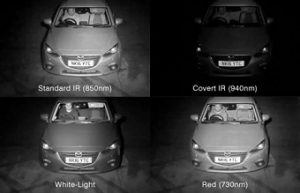
More and more transport applications around the world are trying to identify drivers and passengers who are inside the vehicle. A camera trying to obtain clear, high quality images, inside the vehicle, requires significantly more light than it would in a typical ANPR/LPR application. Here, Raytec explores the difficulties of seeing through the windscreen, and identifies how different wavelengths of light could help to overcome the issues.
Modern windscreens are designed to block out certain wavelengths of light. This is mainly to protect the occupants of the vehicle from ultraviolet (UV) rays, but also in an attempt to keep the cabin cool by blocking infrared (IR). However, the filters do not block all IR rays, just a proportion depending on the specification of the glass. This means IR can still be used for these applications, but a lot more light, and power, is required to achieve the detail necessary to identify a person inside.
One option to overcome this would be to use more power, but this could be expensive and uneconomical. However, what if we change the wavelength of light, moving away from the 850nm IR used for most ANPR/LPR applications?
Overcoming the Challenges
To analyse the effects of different wavelengths, Raytec undertook a series of night-time tests. Using a high-performance camera, they tested four different wavelengths of light (all using the same power) to see how well they performed in a driver or passenger recognition scenario. The wavelengths tested were standard IR (850nm), covert IR (940nm), white-light and red (730nm).
The results showed that each different type of light achieves different results. Although the power of each illuminator is the same, the different wavelength of each means varying levels of light are able to pass through the windscreen in each scenario. The results showed that with standard IR (850nm), the image presented a fairly good level of detail inside the vehicle, helped by the fact the camera is highly sensitive to this wavelength. And aside from the covert IR (940nm), which delivers significantly worse images, at first glance, the other images do not appear to show a huge difference. However, on closer inspection using a zoom it could be seen that 730nm provides a greater level of detail.
In more challenging applications, perhaps when the car is further away or moving at speed, the difference in quality is likely to be more pronounced. Tinting is an additional challenge which affects the quality of images. It means even more light is blocked from passing through the windscreen. The results of the different wavelength illuminators on a tinted rear window were more obvious, it was clear that the 730nm wavelength provides the best results and allows identification of the person.
In an ideal world, the quality of images produced using 730nm could be achieved using an illuminator which gives off no visible light (and therefore offers no distraction to the driver). However, in reality, the further down the spectrum we move, the more light that becomes visible to the driver. Covert IR (940nm) gives off no visible light, but the images are poor. With standard IR (850nm) the quality of the images are good, but there is a visible red glow. Lastly, 730nm achieves excellent quality images with detail of the individual in the car, but there is a very obvious red glow.
The suitability of each wavelength may therefore be country or application specific (depending on the project requirements and preferences). Raytec is continuing to test different wavelengths of light in an attempt to achieve quality images with minimal distraction to the driver. This includes wavelengths in-between those used in this particular test, but also even lower wavelengths (which produce different colours of light).
The deployment of driver and passenger recognition is a topic of hot debate, and the uptake of these systems is very much application and country specific. For example, capturing this level of personal detail may be affected by Data Protection Laws within the country of application.











